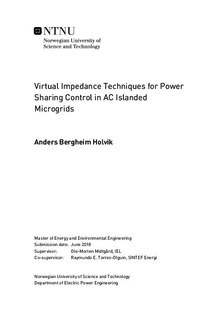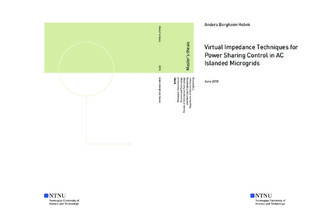| dc.description.abstract | This thesis focuses on power sharing in low-voltage, islanded ac microgrids. It is motivated by the challenges related to climate change. To achieve a successful integration of renewable energy resources in the power grid, it is likely with an increased use of small distributed generation units. A promising way of organizing these units is by the use of microgrids. With microgrids disconnected from the main grid, several challenges related to current, voltage and power flow control arise. These challenges are studied in this thesis, where a microgrid with two distributed generation units and one load is investigated while operating in island mode. The two distributed generation units in the system are implemented with significantly different output impedances, in order to examine the unequal power distribution.
Distributed control systems are developed for this system, especially focusing on the use of virtual impedances for improved power sharing. Proposed virtual impedance methods are presented. These methods reduce the effect the virtual impedances have on the voltage level.
Three different cases are considered, each of which divided into two subcases. In case 1, the microgrid system is assumed to have predominantly resistive output impedances. The subcases 1 a) and 1 b) consider the use of opposite- and conventional droop control algorithms for controlling the voltage and frequency levels. The microgrid considered in case 2 is similar to the one in case 1, but with predominantly inductive output impedances. As in case 1, the conventional and opposite droop control algorithms are utilized in case 2 a) and 2 b), respectively. Case 3 is a reproduction of case 2, but in the selection of virtual impedances, the physical output impedances are estimated to be 25 % lower than the actual values.
Simulation models are carried out in all of the cases by utilizing the software MATLAB/Simulink. Each simulation case considers the use of physical output impedance only, an existing virtual impedance method and a proposed virtual impedance method. The proposed virtual impedance methods show promising results in all cases, where the power sharing performances are the same as for the existing methods. The voltage drops due to the use of virtual impedances are however significantly reduced. All of the simulation cases show a reduction of at least 90 %.
This master's thesis is a part of the research project FME CINELDI, and the results of this thesis are planned to be verified through laboratory experiments. | |

